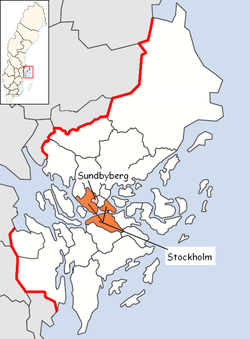
Back بلدية سوندبيباري Arabic بلدية سوندبيبيرج ARZ Сундбіберг (камуна) Byelorussian Сундбюбэрг (камуна) BE-X-OLD Сундбюбери Bulgarian Sundbyberg Catalan Sundbybergs Kommun CEB Sundbyberg Czech Sundbybergs kommun Danish Sundbyberg (Gemeinde) German
City of Sundbyberg
Sundbybergs stad | |
|---|---|
 Fountain on Sundbybergs torg (square) in Central Sundbyberg | |
 | |
| Coordinates: 59°22′N 17°58′E / 59.367°N 17.967°E | |
| Country | Sweden |
| County | Stockholm County |
| Seat | Hallonbergen, part of Stockholm |
| Area | |
| • Total | 8.77 km2 (3.39 sq mi) |
| • Land | 8.67 km2 (3.35 sq mi) |
| • Water | 0.1 km2 (0.04 sq mi) |
| Area as of 1 January 2014. | |
| Population (31 December 2023)[2] | |
| • Total | 55,912 |
| • Density | 6,400/km2 (17,000/sq mi) |
| Demonyms |
|
| Time zone | UTC+1 (CET) |
| • Summer (DST) | UTC+2 (CEST) |
| ISO 3166 code | SE |
| Province | Uppland |
| Municipal code | 0183 |
| Website | www.sundbyberg.se |
| Density is calculated using land area only. | |
Sundbyberg Municipality (Swedish: Sundbybergs kommun or Sundbybergs stad) is a municipality in Stockholm County in east central Sweden, just north of the capital Stockholm. Sundbyberg is wholly within the Stockholm urban area and has a 100% urban population.
Sundbyberg was detached from Bromma (which since 1916 is in Stockholm Municipality) in 1888 as a market town (köping). It got the title of a city in 1927. In 1949 parts of Solna Municipality and Spånga Municipality (when the rest of Spånga was amalgamated into Stockholm) were added. A proposed merger with Solna in 1971 was never implemented, making Sundbyberg, with an area of 8.83 square kilometres (3.41 sq mi), the smallest municipality in Sweden, but also the most densely populated. The municipality prefers to call itself a city, which, however, has no legal significance.
- ^ "Statistiska centralbyrån, Kommunarealer den 1 januari 2014" (in Swedish). Statistics Sweden. 2014-01-01. Archived from the original (Microsoft Excel) on 2016-09-27. Retrieved 2014-04-18.
- ^ "Folkmängd och befolkningsförändringar - Kvartal 4, 2023" (in Swedish). Statistics Sweden. February 22, 2024. Retrieved February 22, 2024.
